Consumer Decision-Making: Analyzing Factors Influencing Laptop Choices
VerifiedAdded on 2023/06/11
|7
|2279
|59
Report
AI Summary
This report analyzes consumer decision-making processes in the context of laptop purchases. It examines survey responses from three different individuals, considering factors such as personality traits, demographics (age, gender, income, and family situation), and their influence on laptop preferences. The analysis utilizes theoretical frameworks from marketing and consumer behavior to explain the variations in evaluative criteria and laptop choices among the respondents. The report also provides recommendations for marketers of laptop options, focusing on understanding target customer characteristics and applying learning and memory theories to attract them effectively. Ultimately, the study highlights the complex interplay of personal factors and marketing strategies in shaping consumer buying decisions. Desklib provides access to a wide range of similar solved assignments and past papers for students.
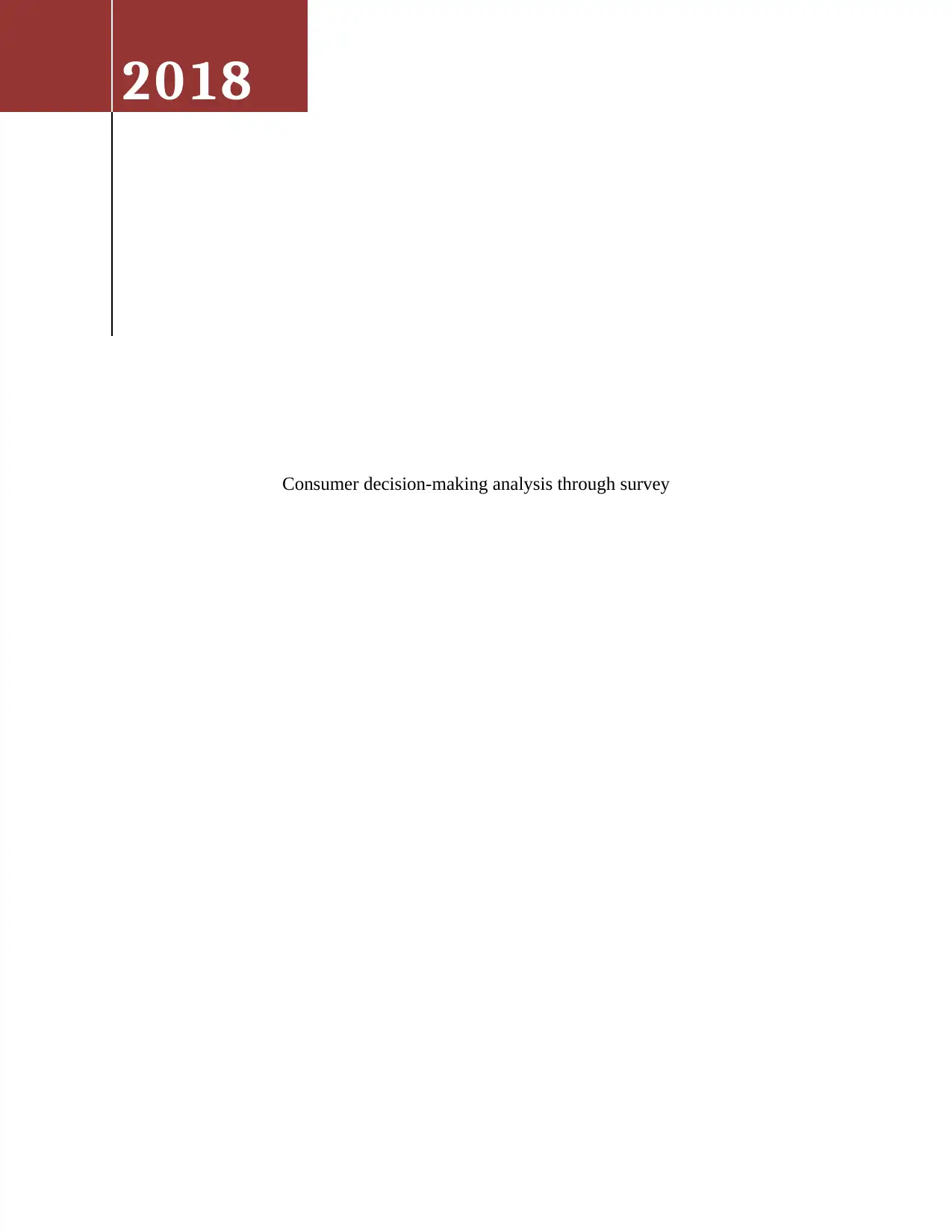
Consumer decision-making analysis through survey
2018
2018
Paraphrase This Document
Need a fresh take? Get an instant paraphrase of this document with our AI Paraphraser
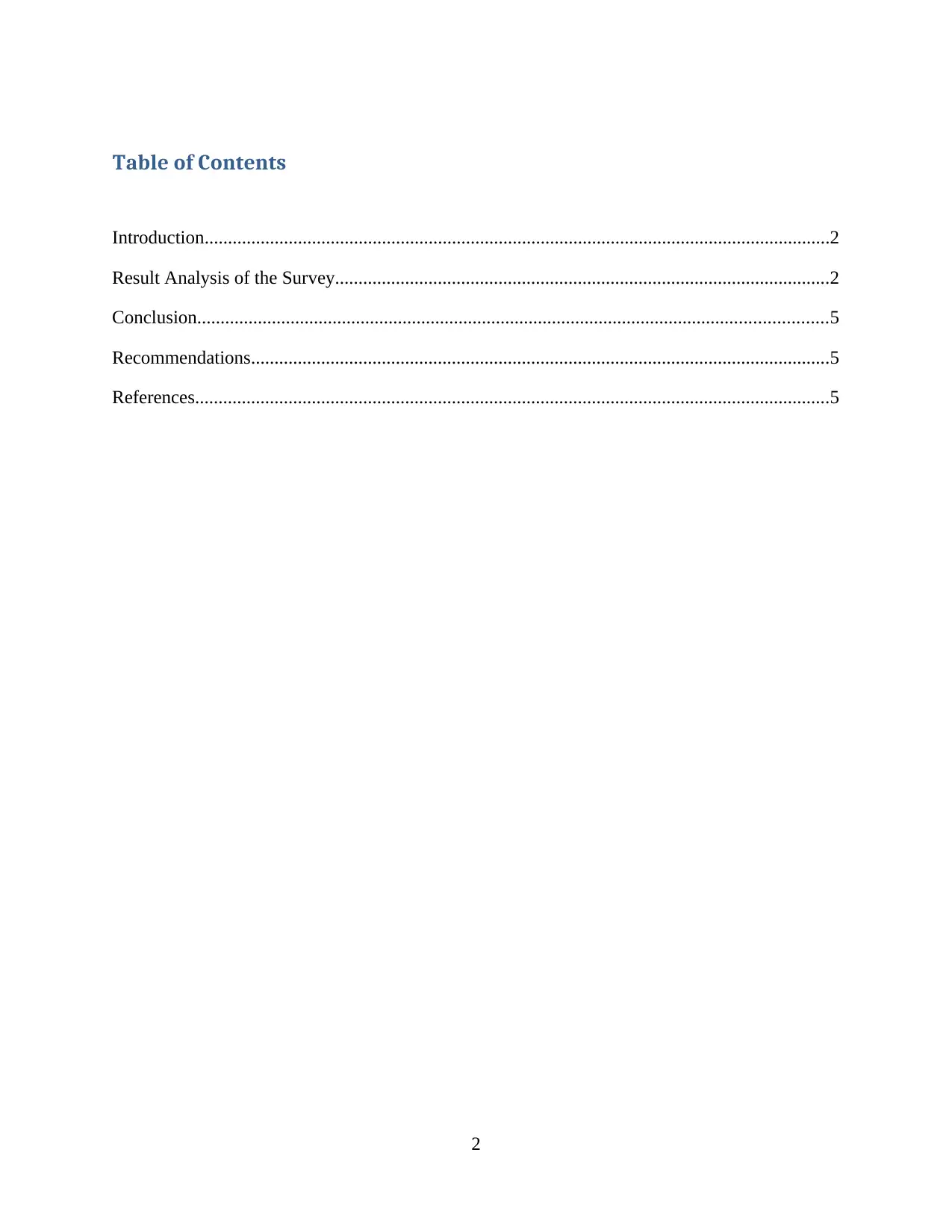
Table of Contents
Introduction......................................................................................................................................2
Result Analysis of the Survey..........................................................................................................2
Conclusion.......................................................................................................................................5
Recommendations............................................................................................................................5
References........................................................................................................................................5
2
Introduction......................................................................................................................................2
Result Analysis of the Survey..........................................................................................................2
Conclusion.......................................................................................................................................5
Recommendations............................................................................................................................5
References........................................................................................................................................5
2
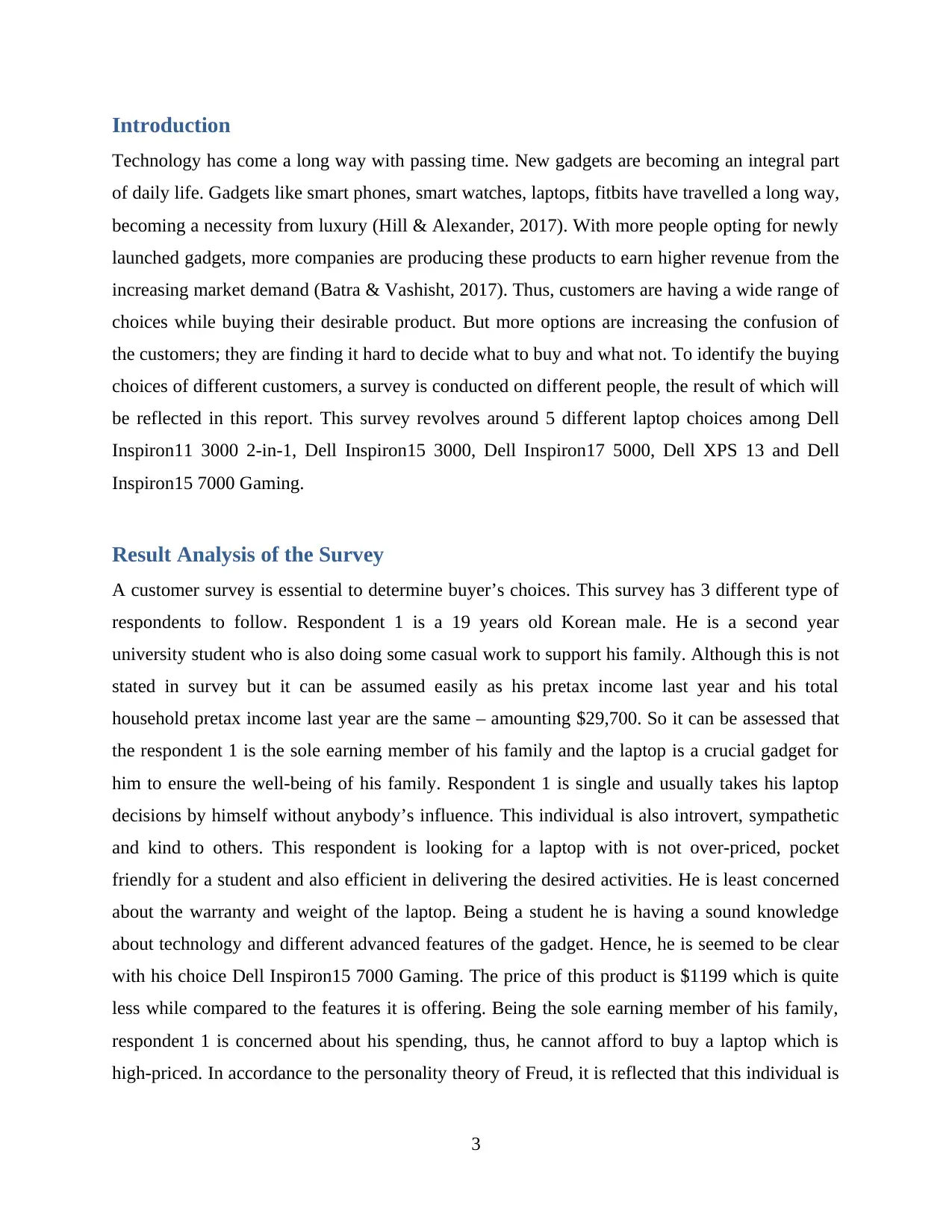
Introduction
Technology has come a long way with passing time. New gadgets are becoming an integral part
of daily life. Gadgets like smart phones, smart watches, laptops, fitbits have travelled a long way,
becoming a necessity from luxury (Hill & Alexander, 2017). With more people opting for newly
launched gadgets, more companies are producing these products to earn higher revenue from the
increasing market demand (Batra & Vashisht, 2017). Thus, customers are having a wide range of
choices while buying their desirable product. But more options are increasing the confusion of
the customers; they are finding it hard to decide what to buy and what not. To identify the buying
choices of different customers, a survey is conducted on different people, the result of which will
be reflected in this report. This survey revolves around 5 different laptop choices among Dell
Inspiron11 3000 2-in-1, Dell Inspiron15 3000, Dell Inspiron17 5000, Dell XPS 13 and Dell
Inspiron15 7000 Gaming.
Result Analysis of the Survey
A customer survey is essential to determine buyer’s choices. This survey has 3 different type of
respondents to follow. Respondent 1 is a 19 years old Korean male. He is a second year
university student who is also doing some casual work to support his family. Although this is not
stated in survey but it can be assumed easily as his pretax income last year and his total
household pretax income last year are the same – amounting $29,700. So it can be assessed that
the respondent 1 is the sole earning member of his family and the laptop is a crucial gadget for
him to ensure the well-being of his family. Respondent 1 is single and usually takes his laptop
decisions by himself without anybody’s influence. This individual is also introvert, sympathetic
and kind to others. This respondent is looking for a laptop with is not over-priced, pocket
friendly for a student and also efficient in delivering the desired activities. He is least concerned
about the warranty and weight of the laptop. Being a student he is having a sound knowledge
about technology and different advanced features of the gadget. Hence, he is seemed to be clear
with his choice Dell Inspiron15 7000 Gaming. The price of this product is $1199 which is quite
less while compared to the features it is offering. Being the sole earning member of his family,
respondent 1 is concerned about his spending, thus, he cannot afford to buy a laptop which is
high-priced. In accordance to the personality theory of Freud, it is reflected that this individual is
3
Technology has come a long way with passing time. New gadgets are becoming an integral part
of daily life. Gadgets like smart phones, smart watches, laptops, fitbits have travelled a long way,
becoming a necessity from luxury (Hill & Alexander, 2017). With more people opting for newly
launched gadgets, more companies are producing these products to earn higher revenue from the
increasing market demand (Batra & Vashisht, 2017). Thus, customers are having a wide range of
choices while buying their desirable product. But more options are increasing the confusion of
the customers; they are finding it hard to decide what to buy and what not. To identify the buying
choices of different customers, a survey is conducted on different people, the result of which will
be reflected in this report. This survey revolves around 5 different laptop choices among Dell
Inspiron11 3000 2-in-1, Dell Inspiron15 3000, Dell Inspiron17 5000, Dell XPS 13 and Dell
Inspiron15 7000 Gaming.
Result Analysis of the Survey
A customer survey is essential to determine buyer’s choices. This survey has 3 different type of
respondents to follow. Respondent 1 is a 19 years old Korean male. He is a second year
university student who is also doing some casual work to support his family. Although this is not
stated in survey but it can be assumed easily as his pretax income last year and his total
household pretax income last year are the same – amounting $29,700. So it can be assessed that
the respondent 1 is the sole earning member of his family and the laptop is a crucial gadget for
him to ensure the well-being of his family. Respondent 1 is single and usually takes his laptop
decisions by himself without anybody’s influence. This individual is also introvert, sympathetic
and kind to others. This respondent is looking for a laptop with is not over-priced, pocket
friendly for a student and also efficient in delivering the desired activities. He is least concerned
about the warranty and weight of the laptop. Being a student he is having a sound knowledge
about technology and different advanced features of the gadget. Hence, he is seemed to be clear
with his choice Dell Inspiron15 7000 Gaming. The price of this product is $1199 which is quite
less while compared to the features it is offering. Being the sole earning member of his family,
respondent 1 is concerned about his spending, thus, he cannot afford to buy a laptop which is
high-priced. In accordance to the personality theory of Freud, it is reflected that this individual is
3
⊘ This is a preview!⊘
Do you want full access?
Subscribe today to unlock all pages.

Trusted by 1+ million students worldwide
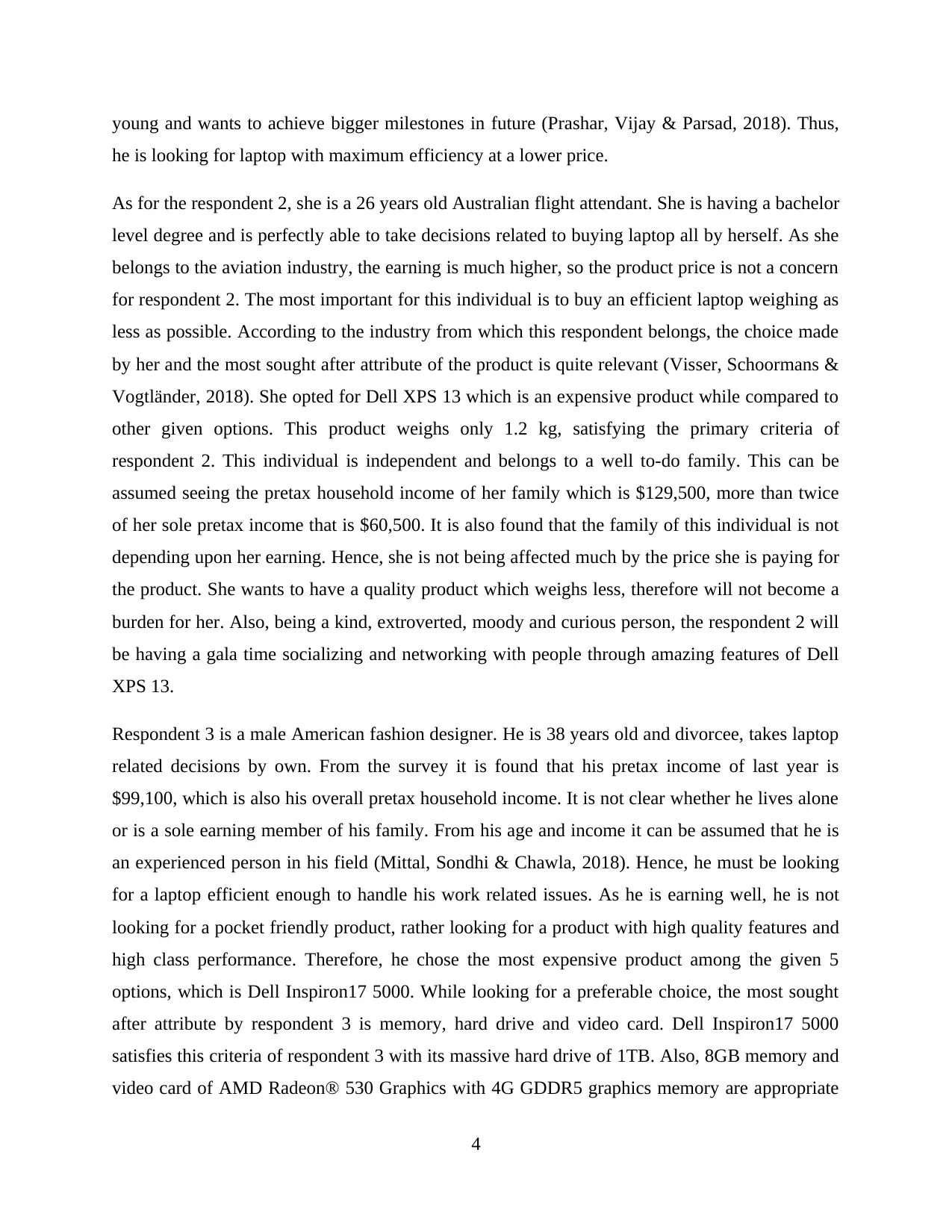
young and wants to achieve bigger milestones in future (Prashar, Vijay & Parsad, 2018). Thus,
he is looking for laptop with maximum efficiency at a lower price.
As for the respondent 2, she is a 26 years old Australian flight attendant. She is having a bachelor
level degree and is perfectly able to take decisions related to buying laptop all by herself. As she
belongs to the aviation industry, the earning is much higher, so the product price is not a concern
for respondent 2. The most important for this individual is to buy an efficient laptop weighing as
less as possible. According to the industry from which this respondent belongs, the choice made
by her and the most sought after attribute of the product is quite relevant (Visser, Schoormans &
Vogtländer, 2018). She opted for Dell XPS 13 which is an expensive product while compared to
other given options. This product weighs only 1.2 kg, satisfying the primary criteria of
respondent 2. This individual is independent and belongs to a well to-do family. This can be
assumed seeing the pretax household income of her family which is $129,500, more than twice
of her sole pretax income that is $60,500. It is also found that the family of this individual is not
depending upon her earning. Hence, she is not being affected much by the price she is paying for
the product. She wants to have a quality product which weighs less, therefore will not become a
burden for her. Also, being a kind, extroverted, moody and curious person, the respondent 2 will
be having a gala time socializing and networking with people through amazing features of Dell
XPS 13.
Respondent 3 is a male American fashion designer. He is 38 years old and divorcee, takes laptop
related decisions by own. From the survey it is found that his pretax income of last year is
$99,100, which is also his overall pretax household income. It is not clear whether he lives alone
or is a sole earning member of his family. From his age and income it can be assumed that he is
an experienced person in his field (Mittal, Sondhi & Chawla, 2018). Hence, he must be looking
for a laptop efficient enough to handle his work related issues. As he is earning well, he is not
looking for a pocket friendly product, rather looking for a product with high quality features and
high class performance. Therefore, he chose the most expensive product among the given 5
options, which is Dell Inspiron17 5000. While looking for a preferable choice, the most sought
after attribute by respondent 3 is memory, hard drive and video card. Dell Inspiron17 5000
satisfies this criteria of respondent 3 with its massive hard drive of 1TB. Also, 8GB memory and
video card of AMD Radeon® 530 Graphics with 4G GDDR5 graphics memory are appropriate
4
he is looking for laptop with maximum efficiency at a lower price.
As for the respondent 2, she is a 26 years old Australian flight attendant. She is having a bachelor
level degree and is perfectly able to take decisions related to buying laptop all by herself. As she
belongs to the aviation industry, the earning is much higher, so the product price is not a concern
for respondent 2. The most important for this individual is to buy an efficient laptop weighing as
less as possible. According to the industry from which this respondent belongs, the choice made
by her and the most sought after attribute of the product is quite relevant (Visser, Schoormans &
Vogtländer, 2018). She opted for Dell XPS 13 which is an expensive product while compared to
other given options. This product weighs only 1.2 kg, satisfying the primary criteria of
respondent 2. This individual is independent and belongs to a well to-do family. This can be
assumed seeing the pretax household income of her family which is $129,500, more than twice
of her sole pretax income that is $60,500. It is also found that the family of this individual is not
depending upon her earning. Hence, she is not being affected much by the price she is paying for
the product. She wants to have a quality product which weighs less, therefore will not become a
burden for her. Also, being a kind, extroverted, moody and curious person, the respondent 2 will
be having a gala time socializing and networking with people through amazing features of Dell
XPS 13.
Respondent 3 is a male American fashion designer. He is 38 years old and divorcee, takes laptop
related decisions by own. From the survey it is found that his pretax income of last year is
$99,100, which is also his overall pretax household income. It is not clear whether he lives alone
or is a sole earning member of his family. From his age and income it can be assumed that he is
an experienced person in his field (Mittal, Sondhi & Chawla, 2018). Hence, he must be looking
for a laptop efficient enough to handle his work related issues. As he is earning well, he is not
looking for a pocket friendly product, rather looking for a product with high quality features and
high class performance. Therefore, he chose the most expensive product among the given 5
options, which is Dell Inspiron17 5000. While looking for a preferable choice, the most sought
after attribute by respondent 3 is memory, hard drive and video card. Dell Inspiron17 5000
satisfies this criteria of respondent 3 with its massive hard drive of 1TB. Also, 8GB memory and
video card of AMD Radeon® 530 Graphics with 4G GDDR5 graphics memory are appropriate
4
Paraphrase This Document
Need a fresh take? Get an instant paraphrase of this document with our AI Paraphraser
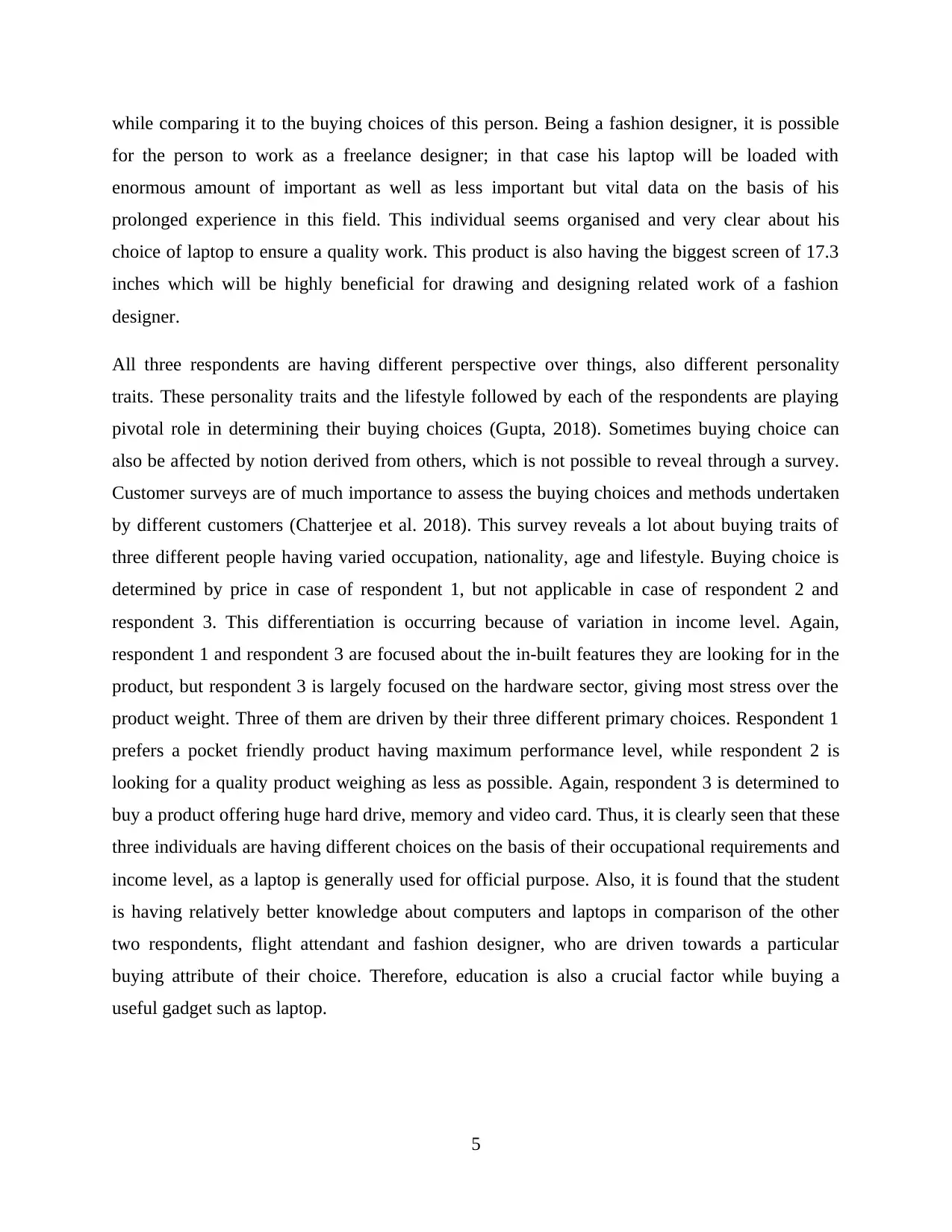
while comparing it to the buying choices of this person. Being a fashion designer, it is possible
for the person to work as a freelance designer; in that case his laptop will be loaded with
enormous amount of important as well as less important but vital data on the basis of his
prolonged experience in this field. This individual seems organised and very clear about his
choice of laptop to ensure a quality work. This product is also having the biggest screen of 17.3
inches which will be highly beneficial for drawing and designing related work of a fashion
designer.
All three respondents are having different perspective over things, also different personality
traits. These personality traits and the lifestyle followed by each of the respondents are playing
pivotal role in determining their buying choices (Gupta, 2018). Sometimes buying choice can
also be affected by notion derived from others, which is not possible to reveal through a survey.
Customer surveys are of much importance to assess the buying choices and methods undertaken
by different customers (Chatterjee et al. 2018). This survey reveals a lot about buying traits of
three different people having varied occupation, nationality, age and lifestyle. Buying choice is
determined by price in case of respondent 1, but not applicable in case of respondent 2 and
respondent 3. This differentiation is occurring because of variation in income level. Again,
respondent 1 and respondent 3 are focused about the in-built features they are looking for in the
product, but respondent 3 is largely focused on the hardware sector, giving most stress over the
product weight. Three of them are driven by their three different primary choices. Respondent 1
prefers a pocket friendly product having maximum performance level, while respondent 2 is
looking for a quality product weighing as less as possible. Again, respondent 3 is determined to
buy a product offering huge hard drive, memory and video card. Thus, it is clearly seen that these
three individuals are having different choices on the basis of their occupational requirements and
income level, as a laptop is generally used for official purpose. Also, it is found that the student
is having relatively better knowledge about computers and laptops in comparison of the other
two respondents, flight attendant and fashion designer, who are driven towards a particular
buying attribute of their choice. Therefore, education is also a crucial factor while buying a
useful gadget such as laptop.
5
for the person to work as a freelance designer; in that case his laptop will be loaded with
enormous amount of important as well as less important but vital data on the basis of his
prolonged experience in this field. This individual seems organised and very clear about his
choice of laptop to ensure a quality work. This product is also having the biggest screen of 17.3
inches which will be highly beneficial for drawing and designing related work of a fashion
designer.
All three respondents are having different perspective over things, also different personality
traits. These personality traits and the lifestyle followed by each of the respondents are playing
pivotal role in determining their buying choices (Gupta, 2018). Sometimes buying choice can
also be affected by notion derived from others, which is not possible to reveal through a survey.
Customer surveys are of much importance to assess the buying choices and methods undertaken
by different customers (Chatterjee et al. 2018). This survey reveals a lot about buying traits of
three different people having varied occupation, nationality, age and lifestyle. Buying choice is
determined by price in case of respondent 1, but not applicable in case of respondent 2 and
respondent 3. This differentiation is occurring because of variation in income level. Again,
respondent 1 and respondent 3 are focused about the in-built features they are looking for in the
product, but respondent 3 is largely focused on the hardware sector, giving most stress over the
product weight. Three of them are driven by their three different primary choices. Respondent 1
prefers a pocket friendly product having maximum performance level, while respondent 2 is
looking for a quality product weighing as less as possible. Again, respondent 3 is determined to
buy a product offering huge hard drive, memory and video card. Thus, it is clearly seen that these
three individuals are having different choices on the basis of their occupational requirements and
income level, as a laptop is generally used for official purpose. Also, it is found that the student
is having relatively better knowledge about computers and laptops in comparison of the other
two respondents, flight attendant and fashion designer, who are driven towards a particular
buying attribute of their choice. Therefore, education is also a crucial factor while buying a
useful gadget such as laptop.
5
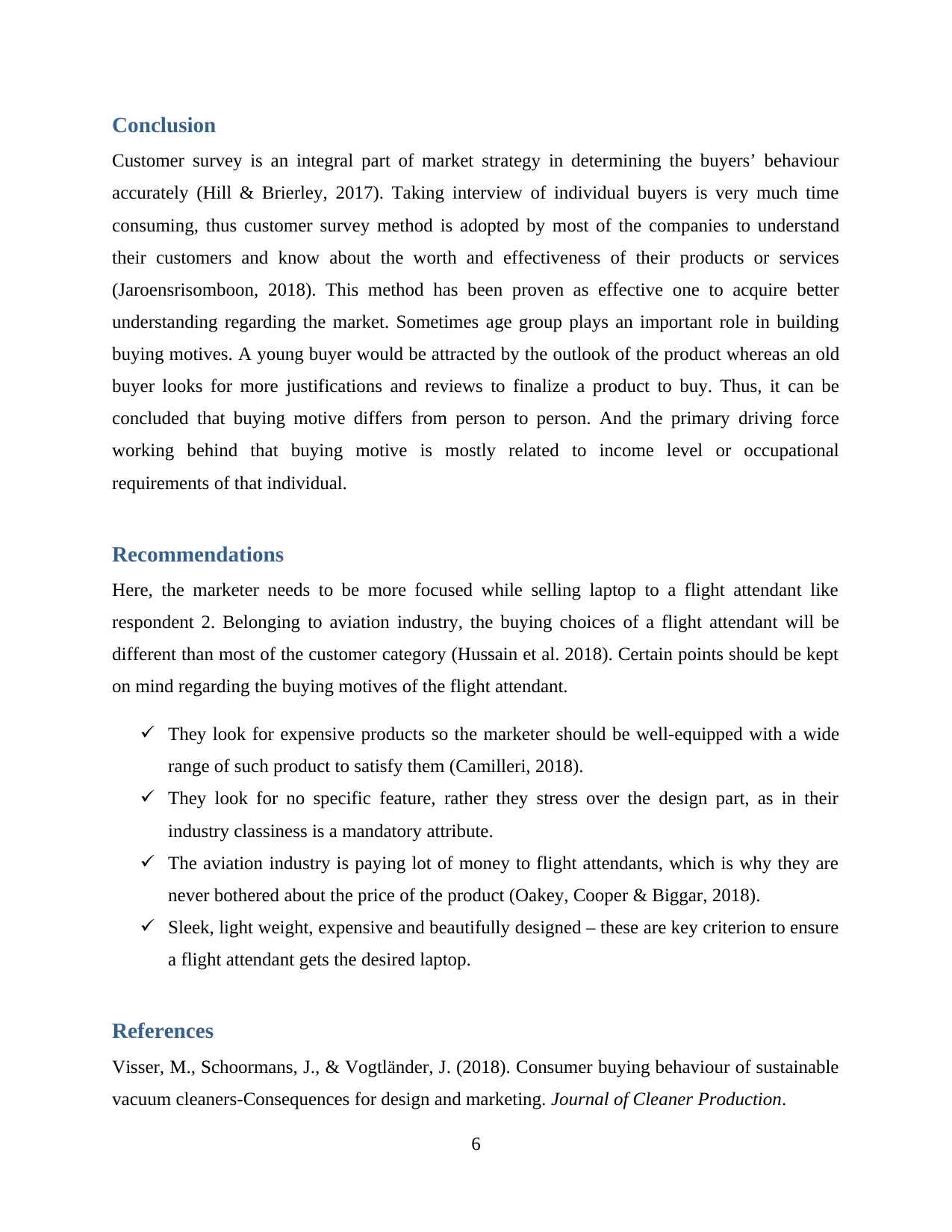
Conclusion
Customer survey is an integral part of market strategy in determining the buyers’ behaviour
accurately (Hill & Brierley, 2017). Taking interview of individual buyers is very much time
consuming, thus customer survey method is adopted by most of the companies to understand
their customers and know about the worth and effectiveness of their products or services
(Jaroensrisomboon, 2018). This method has been proven as effective one to acquire better
understanding regarding the market. Sometimes age group plays an important role in building
buying motives. A young buyer would be attracted by the outlook of the product whereas an old
buyer looks for more justifications and reviews to finalize a product to buy. Thus, it can be
concluded that buying motive differs from person to person. And the primary driving force
working behind that buying motive is mostly related to income level or occupational
requirements of that individual.
Recommendations
Here, the marketer needs to be more focused while selling laptop to a flight attendant like
respondent 2. Belonging to aviation industry, the buying choices of a flight attendant will be
different than most of the customer category (Hussain et al. 2018). Certain points should be kept
on mind regarding the buying motives of the flight attendant.
They look for expensive products so the marketer should be well-equipped with a wide
range of such product to satisfy them (Camilleri, 2018).
They look for no specific feature, rather they stress over the design part, as in their
industry classiness is a mandatory attribute.
The aviation industry is paying lot of money to flight attendants, which is why they are
never bothered about the price of the product (Oakey, Cooper & Biggar, 2018).
Sleek, light weight, expensive and beautifully designed – these are key criterion to ensure
a flight attendant gets the desired laptop.
References
Visser, M., Schoormans, J., & Vogtländer, J. (2018). Consumer buying behaviour of sustainable
vacuum cleaners-Consequences for design and marketing. Journal of Cleaner Production.
6
Customer survey is an integral part of market strategy in determining the buyers’ behaviour
accurately (Hill & Brierley, 2017). Taking interview of individual buyers is very much time
consuming, thus customer survey method is adopted by most of the companies to understand
their customers and know about the worth and effectiveness of their products or services
(Jaroensrisomboon, 2018). This method has been proven as effective one to acquire better
understanding regarding the market. Sometimes age group plays an important role in building
buying motives. A young buyer would be attracted by the outlook of the product whereas an old
buyer looks for more justifications and reviews to finalize a product to buy. Thus, it can be
concluded that buying motive differs from person to person. And the primary driving force
working behind that buying motive is mostly related to income level or occupational
requirements of that individual.
Recommendations
Here, the marketer needs to be more focused while selling laptop to a flight attendant like
respondent 2. Belonging to aviation industry, the buying choices of a flight attendant will be
different than most of the customer category (Hussain et al. 2018). Certain points should be kept
on mind regarding the buying motives of the flight attendant.
They look for expensive products so the marketer should be well-equipped with a wide
range of such product to satisfy them (Camilleri, 2018).
They look for no specific feature, rather they stress over the design part, as in their
industry classiness is a mandatory attribute.
The aviation industry is paying lot of money to flight attendants, which is why they are
never bothered about the price of the product (Oakey, Cooper & Biggar, 2018).
Sleek, light weight, expensive and beautifully designed – these are key criterion to ensure
a flight attendant gets the desired laptop.
References
Visser, M., Schoormans, J., & Vogtländer, J. (2018). Consumer buying behaviour of sustainable
vacuum cleaners-Consequences for design and marketing. Journal of Cleaner Production.
6
⊘ This is a preview!⊘
Do you want full access?
Subscribe today to unlock all pages.

Trusted by 1+ million students worldwide
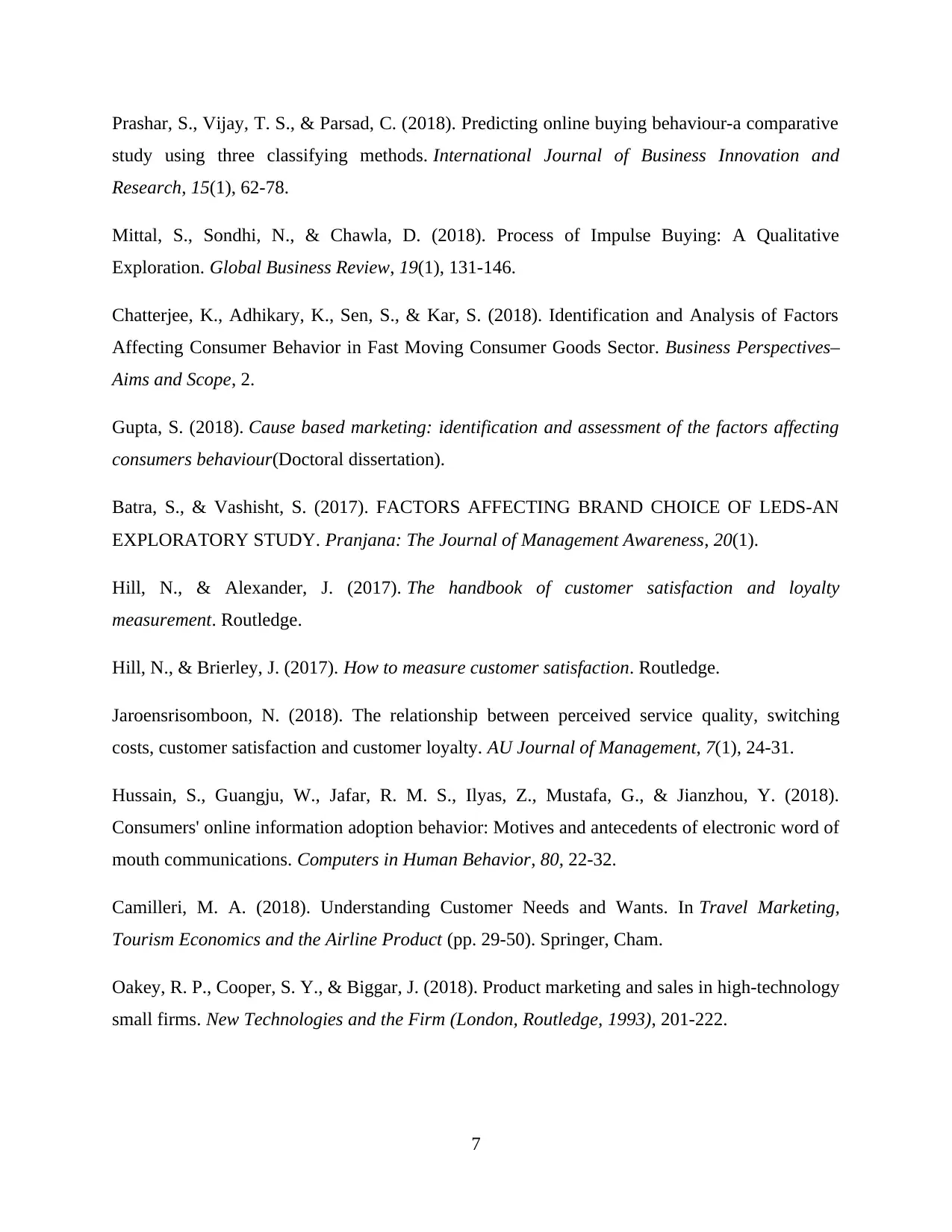
Prashar, S., Vijay, T. S., & Parsad, C. (2018). Predicting online buying behaviour-a comparative
study using three classifying methods. International Journal of Business Innovation and
Research, 15(1), 62-78.
Mittal, S., Sondhi, N., & Chawla, D. (2018). Process of Impulse Buying: A Qualitative
Exploration. Global Business Review, 19(1), 131-146.
Chatterjee, K., Adhikary, K., Sen, S., & Kar, S. (2018). Identification and Analysis of Factors
Affecting Consumer Behavior in Fast Moving Consumer Goods Sector. Business Perspectives–
Aims and Scope, 2.
Gupta, S. (2018). Cause based marketing: identification and assessment of the factors affecting
consumers behaviour(Doctoral dissertation).
Batra, S., & Vashisht, S. (2017). FACTORS AFFECTING BRAND CHOICE OF LEDS-AN
EXPLORATORY STUDY. Pranjana: The Journal of Management Awareness, 20(1).
Hill, N., & Alexander, J. (2017). The handbook of customer satisfaction and loyalty
measurement. Routledge.
Hill, N., & Brierley, J. (2017). How to measure customer satisfaction. Routledge.
Jaroensrisomboon, N. (2018). The relationship between perceived service quality, switching
costs, customer satisfaction and customer loyalty. AU Journal of Management, 7(1), 24-31.
Hussain, S., Guangju, W., Jafar, R. M. S., Ilyas, Z., Mustafa, G., & Jianzhou, Y. (2018).
Consumers' online information adoption behavior: Motives and antecedents of electronic word of
mouth communications. Computers in Human Behavior, 80, 22-32.
Camilleri, M. A. (2018). Understanding Customer Needs and Wants. In Travel Marketing,
Tourism Economics and the Airline Product (pp. 29-50). Springer, Cham.
Oakey, R. P., Cooper, S. Y., & Biggar, J. (2018). Product marketing and sales in high-technology
small firms. New Technologies and the Firm (London, Routledge, 1993), 201-222.
7
study using three classifying methods. International Journal of Business Innovation and
Research, 15(1), 62-78.
Mittal, S., Sondhi, N., & Chawla, D. (2018). Process of Impulse Buying: A Qualitative
Exploration. Global Business Review, 19(1), 131-146.
Chatterjee, K., Adhikary, K., Sen, S., & Kar, S. (2018). Identification and Analysis of Factors
Affecting Consumer Behavior in Fast Moving Consumer Goods Sector. Business Perspectives–
Aims and Scope, 2.
Gupta, S. (2018). Cause based marketing: identification and assessment of the factors affecting
consumers behaviour(Doctoral dissertation).
Batra, S., & Vashisht, S. (2017). FACTORS AFFECTING BRAND CHOICE OF LEDS-AN
EXPLORATORY STUDY. Pranjana: The Journal of Management Awareness, 20(1).
Hill, N., & Alexander, J. (2017). The handbook of customer satisfaction and loyalty
measurement. Routledge.
Hill, N., & Brierley, J. (2017). How to measure customer satisfaction. Routledge.
Jaroensrisomboon, N. (2018). The relationship between perceived service quality, switching
costs, customer satisfaction and customer loyalty. AU Journal of Management, 7(1), 24-31.
Hussain, S., Guangju, W., Jafar, R. M. S., Ilyas, Z., Mustafa, G., & Jianzhou, Y. (2018).
Consumers' online information adoption behavior: Motives and antecedents of electronic word of
mouth communications. Computers in Human Behavior, 80, 22-32.
Camilleri, M. A. (2018). Understanding Customer Needs and Wants. In Travel Marketing,
Tourism Economics and the Airline Product (pp. 29-50). Springer, Cham.
Oakey, R. P., Cooper, S. Y., & Biggar, J. (2018). Product marketing and sales in high-technology
small firms. New Technologies and the Firm (London, Routledge, 1993), 201-222.
7
1 out of 7
Your All-in-One AI-Powered Toolkit for Academic Success.
+13062052269
info@desklib.com
Available 24*7 on WhatsApp / Email
![[object Object]](/_next/static/media/star-bottom.7253800d.svg)
Unlock your academic potential
Copyright © 2020–2025 A2Z Services. All Rights Reserved. Developed and managed by ZUCOL.

